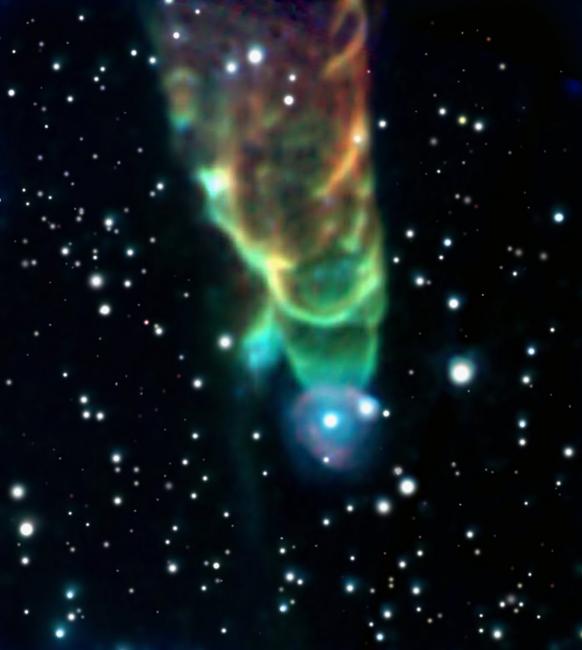- Telescopes
- Planetary Nebulas
- Star Formation
- Interstellar Medium and Molecular Clouds
- Star Clusters
- Galaxy Formation and Evolution

Cambridge, MA
For the last 1000 days the Infrared Array Camera (IRAC), aboard NASA's Spitzer Space Telescope, has been operating continuously to probe the universe from its most distant regions to our local solar neighborhood. The IRAC "warm" program began once Spitzer used up its liquid helium coolant, thus completing its "cold" mission. To commemorate 1000 days of infrared wonders, the program is releasing a gallery of the 10 best IRAC images.
"IRAC continues to be an amazing camera, still producing important discoveries and spectacular new images of the infrared universe," said principal investigator Giovanni Fazio of the Harvard-Smithsonian Center for Astrophysics.
The warm-mission images particularly highlight the continuing capabilities of Spitzer. Indeed, NASA's Senior Review Panel has recommended extending the Spitzer warm mission through 2015. They specifically commended the Spitzer team for telescope improvements that have made it a powerful instrument for science, especially in exoplanet studies.
IRAC is sensitive to infrared light - light beyond the red end of the visible spectrum. It can image nebulae of cold dust, peer inside obscured dust clouds where new stars are forming, and detect faint emissions from very distant galaxies.
During its 1000-day undertaking, IRAC used its two shortest-wavelength infrared sensors. However, some of the images featured today include data collected during the cold mission, when all four of its infrared sensors could function.
The top 10 IRAC images the team selected are:
- A "space tornado"
- The Orion Nebula
- The Helix Nebula
- The Trifid Nebula
- The "Mountains of Creation"
- A young star cluster
- Our Milky Way galaxy
- The Whirlpool galaxy
- The Sombrero galaxy
- The young, distant universe
Many additional images from Spitzer can be found online at http://www.spitzer.caltech.edu/.
Headquartered in Cambridge, Mass., the Harvard-Smithsonian Center for Astrophysics (CfA) is a joint collaboration between the Smithsonian Astrophysical Observatory and the Harvard College Observatory. CfA scientists, organized into six research divisions, study the origin, evolution and ultimate fate of the universe.
David A. Aguilar
Director of Public Affairs
Harvard-Smithsonian Center for Astrophysics
617-495-7462
daguilar@cfa.harvard.edu
Christine PulliamPublic Affairs Specialist
Harvard-Smithsonian Center for Astrophysics
617-495-7463
cpulliam@cfa.harvard.edu
Related News
CfA Scientists Play Important Role in New NASA Mission
Runaway Stars Reveal Hidden Black Hole In Milky Way’s Nearest Neighbor
CfA Celebrates 25 Years with the Chandra X-ray Observatory
CfA Astronomers Help Find Most Distant Galaxy Using James Webb Space Telescope
Unexpectedly Massive Black Holes Dominate Small Galaxies in the Distant Universe
Distant Stars Spotted for the First Time in the Vast Magellanic Stream
CfA Scientists Help Reach New Milestone in Quest for Distant Galaxies
Astrophysicists Hunt for Second-Closest Supermassive Black Hole
The Tilt in our Stars: The Shape of the Milky Way's Halo of Stars is Realized
JWST Draws Back Curtain on Universe's Early Galaxies
Projects
2MASS Redshift Survey
AstroAI
Dark Energy Spectroscopic Instrument (DESI)
GMACS
For Scientists